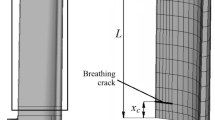The paper considers the implementation of the rapid method of predicting the dynamic stability of the compressor blade assemblies against subsonic flutter. The first flexural mode of blade vibrations is analyzed at the design stage for a wide range of the angle of attack based on the developed database of the critical values of the reduced vibration frequency in straight cascades of blade airfoils. The multiple regression equation is developed that depends on the relative blade spacing and stagger angle of the straight cascade of blade airfoils, coefficient of the flexural-torsional coupling of the blade, and angle of attack with the correlation factor of the studied parameters in the range of 0.92–0.98. Using the obtained equation, the numerical program has been developed for the determination of the dynamic stability limit against subsonic flutter for the first flexural mode of the blade vibrations. The program allows one to find the numerical values of critical reduced frequencies as the characteristics of its dynamic stability and determine their dependence on the angle of attack. The results of practical application of the developed program are presented using the assessment of the dynamic stability of the flexural mode of axial compressors in four modern aircraft gas-turbine engines. It is shown that at the design engine stage it is possible to select the reduced vibration frequencies of the blade assembly for the specified geometry of its peripheral sections and angle of attack of the inflow upon the condition of the occurrence of subsonic flutter.






Similar content being viewed by others
References
A. L. Stel’makh, A. P. Zinkovskii, and S. N. Kabannik, “Rapid method of predicting the subsonic flutter stability of AGTE axial-flow compressor blade cascades. Part 1. Physical backgrounds of the method,” Strength Mater., 51, No. 2, 175–182 (2019).
S. N. Kabannik, A. L. Stel’makh, and A. P. Zinkovskii, “Algorithm of implementation of rapid assessment of stability against subsonic flutter of compressor blade assemblies,” Aviats.-Kosm. Tekh. Tekhnol., 8 (115), 131–137 (2014).
S. L. Akhnazarova and V. V. Kafarov, Methods of Optimization of the Experiment in Chemical Process [in Russian], Vysshaya Shkola, Moscow (1985). 697
Author information
Authors and Affiliations
Corresponding author
Additional information
Translated from Problemy Prochnosti, No. 5, pp. 5 – 15, September – October, 2019. Original article submitted December 7, 2017.
Rights and permissions
About this article
Cite this article
Zinkovskii, A.P., Kabannik, S.N. & Stel’makh, A.L. Rapid method of Predicting the Subsonic Flutter Stability of AGTE Axial-Flow Compressor Blade Cascades. Part 2. Mathematical Implementation of Method and its Potentional Application. Strength Mater 51, 689–697 (2019). https://doi.org/10.1007/s11223-019-00117-1
Received:
Published:
Issue Date:
DOI: https://doi.org/10.1007/s11223-019-00117-1




